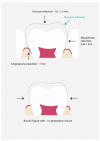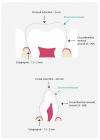Review on Preformed Crowns in Pediatric Dentistry-The Composition and Application
- PMID: 35329535
- PMCID: PMC8950869
- DOI: 10.3390/ma15062081
Review on Preformed Crowns in Pediatric Dentistry-The Composition and Application
Abstract
The purpose of this review is to compare and contrast the various types of preformed crowns that can be used to restore the primary teeth in children. Historically, preformed crowns have been widely available for the past 50 years. The clinical performance of preformed crowns has evolved to meet higher functional, mechanical, and aesthetic demands. Preformed crowns are available in a range of prefabricated sizes and shapes. Preformed crowns can vary depending on their properties, compounds, methods of preparation, and biocompatibility.
Keywords: material composition; pediatric crowns; primary teeth; repair procedures; teeth restoration.
Conflict of interest statement
The authors declare no conflict of interest. The funders had no role in the design of the study, data collection, analysis, and interpretation, writing of the manuscript, and the decision to publish the results.
Figures








Similar articles
-
Release and systemic accumulation of heavy metals from preformed crowns used in restoration of primary teeth.J Oral Sci. 2013;55(2):161-5. doi: 10.2334/josnusd.55.161. J Oral Sci. 2013. PMID: 23748456
-
Preformed pediatric zirconia crown versus preformed pediatric metal crown: study protocol for a randomized clinical trial.Trials. 2019 Aug 24;20(1):530. doi: 10.1186/s13063-019-3559-1. Trials. 2019. PMID: 31445509 Free PMC article.
-
[Guideline on operation of stainless steel crown for decidous teeth restoration].Zhonghua Kou Qiang Yi Xue Za Zhi. 2020 Aug 9;55(8):551-554. doi: 10.3760/cma.j.cn112144-20200514-00270. Zhonghua Kou Qiang Yi Xue Za Zhi. 2020. PMID: 32842346 Chinese.
-
Preformed posterior stainless steel crowns: an update.Compend Contin Educ Dent. 1999 Feb;20(2):89-92, 94-6, 98-100 passim; quiz 106. Compend Contin Educ Dent. 1999. PMID: 11692330 Review.
-
The interaction and interference of preformed metal crowns on magnetic resonance imaging: a scoping review with a systematic methodology.Eur Arch Paediatr Dent. 2021 Dec;22(6):1023-1031. doi: 10.1007/s40368-021-00644-z. Epub 2021 Jun 11. Eur Arch Paediatr Dent. 2021. PMID: 34115334 Free PMC article.
Cited by
-
The Impact of Environmental and Material Factors on Fluoride Release from Metal-Modified Glass Ionomer Cements: A Systematic Review of In Vitro Studies.Materials (Basel). 2025 Jul 5;18(13):3187. doi: 10.3390/ma18133187. Materials (Basel). 2025. PMID: 40649675 Free PMC article. Review.
-
Toxic Metal Content in Deciduous Teeth: A Systematic Review.Toxics. 2025 Jun 30;13(7):556. doi: 10.3390/toxics13070556. Toxics. 2025. PMID: 40711001 Free PMC article. Review.
-
Managing Early Childhood Caries: A Comparative Review of Preventive and Restorative Approaches.Cureus. 2024 Nov 28;16(11):e74704. doi: 10.7759/cureus.74704. eCollection 2024 Nov. Cureus. 2024. PMID: 39735036 Free PMC article. Review.
-
Clinical and radiographic outcomes of endocrowns fabricated from two different CAD-CAM materials versus stainless steel crowns in restoring first permanent molars in children: a randomized clinical trial.BMC Oral Health. 2025 Jul 8;25(1):1127. doi: 10.1186/s12903-025-06507-z. BMC Oral Health. 2025. PMID: 40629344 Free PMC article. Clinical Trial.
-
Strategies for Restoration of Compromised First Permanent Molars in Children: Challenges and Optimal Timing.Oral Health Prev Dent. 2025 Aug 8;23:435-446. doi: 10.3290/j.ohpd.c_2175. Oral Health Prev Dent. 2025. PMID: 40778742 Free PMC article. Review.
References
-
- World Health Organization Oral Health. [(accessed on 25 March 2020)]. Available online: https://www.who.int/news-room/fact-sheets/detail/oral-health.
-
- UK Oral Health Survey of 5-Year-Old Children 2019. [(accessed on 20 March 2020)];2020 Available online: https://www.gov.uk/government/statistics/oral-health-survey-of-5-year-ol....
-
- Scotland’s National Dental Inspection Programme 2003. [(accessed on 11 January 2020)]. Available online: http://www.dundee.ac.uk/ndip/index.htm.
-
- O’Brien M. Children’s Dental Health in the United Kingdom 1993. H.M. Stationery Office; London, UK: 1994. pp. 5–17.
Publication types
LinkOut - more resources
Full Text Sources
Medical
Miscellaneous

